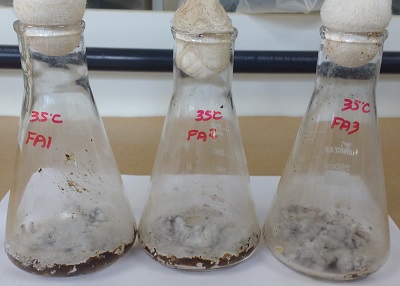Avocado seed meal as an alternative substrate for pectinase production by Gongronella butleri
DOI:
https://doi.org/10.20873/jbb.uft.cemaf.v11n1.bragaKeywords:
enzymatic bioproduction, bioprocesses, solid state cultivationAbstract
The use of leftovers or refuse from agricultural and/or agro-industrial production for the cultivation of microorganisms with enzyme production has become constant, as well as being suitable as a sustainable alternative; adds value to by-products; and also acts as a mitigation strategy for environmental changes. The present work aimed to study the profile of the bioconversion activity of avocado kernel flour, carried out by the fungal strain Gongronella butleri, in order to produce pectinases. The fungal strain was inoculated in triplicate, in flasks containing freeze-dried avocado seed meal, which were previously moistened with nutrient saline solution and sterilized. Fermentations took place at 35ºC for 24, 48, 72, 96 and 120 h. The production profile of pectinases over time was determined by measuring the enzymatic activity (U g-1) of the crude extract obtained in the fermentations, using spectrophotometry at 540 nm, according to the standard method of reduction of 3,5-dinitrosalicylic acid (DNS). The avocado kernel flour induced the production of enzymes, with an increase in pectinolytic activity with the course of fermentation, reaching the peak of highest activity (19.43 U g-1) at 96 h. In comparison with studies that used microbial genera considered standard for the fermentation of agro-industrial "waste" and the production of pectinases, the fungal strain of G. butleri, presents itself as a potential alternative biological agent in the production of pectinases, when compared to stone flour from avocado, especially if optimization tests are applied.
References
Abdullah R, Jafer A, Nisar K, Kaleen A, Iqtedar M, Iftikhar T et al Saleen F, Naz S. Process optimization for pectinase production by locally isolated fungal strain using submerged fermentation. Bioscience Journal, v.33, n.4, p.1025-1032, 2018. https://doi.org/10.14393/Bj-v34n1a2018-39947
Amin F, Bhatti HN, Bilal M. Recent advances in the produc-tion strategies of microbial pectinases - A review. Internati-onal Journal of Biological Macromolecules, v.122, p.1017-1026, 2019. https://doi.org/10.1016/j.ijbiomac.2018.09.048
BCC Research: Market Research Reports & Industry Analys-is. (2018). Global Industrial Enzymes Market. Disponível em: https://www.bccresearch.com/partners/verified-market-research/global-industrial-enzymes-market.html. Acessado em Outubro, 2022.
Braga HF, Alves-Prado HF, Baffi MA. Perfil de produção de pectinases por fungo isolado do solo do Cerrado, frente ao coproduto palha de milho, empregando cultivo em estado sólido. In: Simpósio de Biociências e Microbiologia. São José do Rio Preto, UNESP/IBILCE, p.68-70. 2019.
Coelho MAZ, Leite SGF, Rosa MF, Furtado AAL. Aprovei-tamento de resíduos agroindustriais: produção de enzimas a partir da casca de coco verde. Boletim do Centro de Pesqui-sa de Processamento de Alimentos, v.19, n.1, p.33-42, 2001. http://dx.doi.org/10.5380/cep.v19i1.1220
Deliberador LR, Batalha, MO, Freire CD, Fontenelle AM, Sabadini FC. Perdas e desperdícios de alimentos ao longo da cadeia de suprimentos: uma análise de regiões desenvol-vidas e em desenvolvimento. South American Development Society Journal, v.4, n.01, p.11-27, 2018. http://dx.doi.org/10.24325/issn.2446-5763.vespi1p11-27
Miller GL. Use of dinitrosalicylic acid reagent for determina-tion of reducing sugars. Analytical Chemistry, v.31, n.3, p.426-428, 1959. https://doi.org/10.1021/ac60147a030
Moreira AM. Bioeconomia: plataforma mundial de inovação e sustentabilidade nas cadeias agroindustriais. Revista Proces-sos Químicos, v.10, n.20, p.351-353, 2016. https://doi.org/10.19142/rpq.v10i20.384
Nascimento MRF, Souza VF, Marinho AF, Ascheri JLR, Meleiro CHA. Composição centesimal e minerais de farinha de caroço de abacate (Persea gratissima, Gaertner f.). In: Congresso Brasileiro de Ciência e Tecnologia de Alimentos. Gramado, SBCTA. p. 25. 2016.
Panda, SK, Mishra SS, Kayitesi E, Ray RC. Microbial-processing of fruit and vegetable wastes for production of vital enzymes and organic acids: biotechnology and scopes. Environmental Research, v.146, p.161-172, 2016. https://doi.org/10.1016/j.envres.2015.12.035
Pitol LO, Biz A, Mallmann E, Krieger N, Mitchell DA. Pro-duction of pectinases by solid-state fermentation in a pilot-scale packed-bed bioreactor. Chemical Engineering Journal, v.283, p.1009-1018, 2016. https://doi.org/10.1016/j.cej.2015.08.046
Rocha CP. Otimização da produção de enzimas por Asper-gillus niger em fermentação em estado sólido. 2010. 161 f. Dissertação (Mestrado em Engenharia Química) - Universi-dade Federal de Uberlândia, Uberlândia.
Santos PS, Solidade LS, Souza JGB, Lima GS, Braga Jr ACR, Assis FGV et al. Fermentação em estado sólido em resíduos agroindustriais para a produção de enzimas: uma revisão sistemática. The Journal of Engineering and Exact Sciences, v.4, n.2, p.0181-0188, 2018. https://doi.org/10.18540/jcecvl4iss2pp0181-0188
Silva FM, Pedroza MM, Oliveira LRA, Colen AGN, Amaral PHB. Rotas tecnológicas empregadas no aproveitamento de resíduos da indústria da soja. Revista Brasileira de Energias Renováveis, v.8, n.1, p.326-363, 2019. http://dx.doi.org/10.5380/rber.v8i1.57694
Silva GF, Megale MHDS. O direito ao futuro como manda-mento ético: a sustentabilidade e o modelo de produção ali-mentar no Brasil. Revista Gestão & Sustentabilidade Ambi-ental, v.9, n.II, p.811-822, 2020. http://dx.doi.org/10.19177/rgsa.v9e02020811-822
Souza EFFS, Souza EFS, Silva LDB, Resende CGF, Nascen-tes AL. Avaliação da capacidade adsortiva do sabugo de mi-lho triturado. Brazilian Journal of Animal and Environmen-tal Research, v.2, n.4, p.1174-1190, 2019.
Veronezi CM, Jorge N. Aproveitamento de sementes de abó-bora (Curcubita sp.) como fonte alimentar. Revista Brasilei-ra de Produtos Agroindustriais, v.14, n.1, p.113-124, 2012. http://dx.doi.org/10.15871/1517-595/rbpa.v14n1p113-124

Downloads
Published
How to Cite
Issue
Section
License
Copyright (c) 2023 Héberly Fernandes Braga, Milla Alves Baffi, Heloiza Ferreira Alves do Prado

This work is licensed under a Creative Commons Attribution 4.0 International License.
Copyright (c) 2024 - Journal of Biotechnology and Biodiversity

This work is licensed under a Creative Commons Attribution 4.0 International License.
Authors who publish with this journal agree to the following terms:
Authors retain copyright and grant the journal right of first publication with the work simultaneously licensed under a Creative Commons Attribution License (CC BY 4.0 at http://creativecommons.org/licenses/by/4.0/) that allows others to share the work with an acknowledgement of the work's authorship and initial publication in this journal.
Authors are able to enter into separate, additional contractual arrangements for the non-exclusive distribution of the journal's published version of the work (e.g., post it to an institutional repository or publish it in a book), with an acknowledgement of its initial publication in this journal.
Authors are permitted and encouraged to post their work online (e.g. in institutional repositories or on their website) prior to and during the submission process, as it can lead to productive exchanges, as well as earlier and greater citation of published work (Available at The Effect of Open Access, at http://opcit.eprints.org/oacitation-biblio.html).


